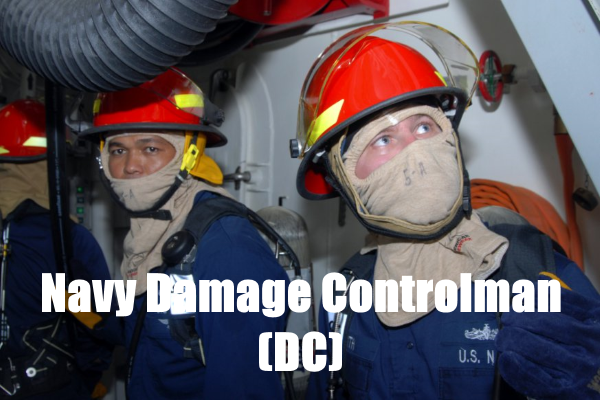When a fire breaks out on board ship, there is no 911 to call. There is only Damage Control Central (DCC). The DCC is the Emergency Services of the fleet, and Damage Controlman (DC) are the firefighters of the DCC.
“When the (emergency) bells go off, we’re there no matter what the time,” explains USS Carl Vinson (DD 563) Damage Controlman Second Class (DC2) Alex Montoya.
DC2 Montoya’s Leading Petty Officer (LPO) DC1 (SW) Gary Leibowitz, expands on his sailor’s thoughts, “The ship’s mission is like a heart, and we are the ribs. We encompass the ship and protect it…”
They are the enlisted men and women of the U.S. Navy who do the work necessary for ship stability, firefighting, fire prevention, damage control, and chemical, biological, and radiological (CBR) warfare defense.
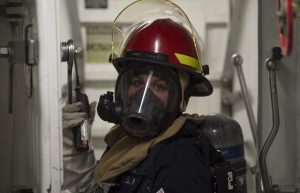
In addition, DCs instruct all of their shipmates (regardless of their job or rate) in the methods of firefighting, CBR defense, and damage control.
Related Article – Navy Jobs List: A List Of All 71 Ratings In The Navy
They also repair damage control equipment and systems.
Whether onboard a ship, submarine, as part of an air squadron, or any Navy shore facility around the globe, you’ll find a Navy DC on the job.
There are approximately 3,300 DC’s serving in the US Navy today.
Jump To A Section
Requirements and Qualifications
To become a Navy Damage Controlman, there are specific requirements and qualifications that you must meet:
- Must be a member of the US Navy.
- Citizenship requirements may vary.
- Must be between the ages of 18 and 39.
- Must have no record of adversely adjudicated drug abuse offenses.
- Must have good vision and normal color perception.
- Must have an Armed Forces Vocational Aptitude Battery (ASVAB) score of VE (Verbal Expression) + AR (Arithmetic Reasoning) + MK (Math Knowledge) + AS (Auto Shop) = 193 or VE (Verbal Expression) + AR (Arithmetic Reasoning) + MK (Math Knowledge) + MC (Mechanical Comprehension) = 193.
Related Article: Navy Height And Weight Standards
Training and Career Path
Prior to becoming a Navy Damage Controlman, you must first become a US Navy Sailor. Recruits accomplish this via successful completion of Navy Recruit Training, commonly referred to as Boot Camp.
All sailors attend Boot Camp at the Recruit Training Command, Great Lakes (RTC Great Lakes).
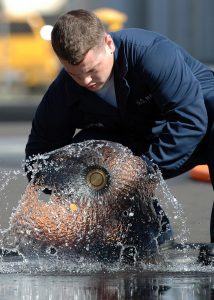
Located at Naval Station Great Lakes in North Chicago, Illinois in Lake County. RTC Great Lakes is commonly referred to as “The Quarterdeck of the Navy.”
Boot Camp is eight weeks long. During these eight weeks, the Navy will teach you the basic skills required of all US Sailors.
Related Article – Is Navy Boot Camp Hard?
Navy Damage Controlman Class “A” School
After Boot Camp, future DC’s must attend Navy Damage Controlman (DC) Class “A” School also at Naval Station Great Lakes, Illinois.
During Damage Control Navy A School, which is about 10 weeks long with group instruction and practical application, study:
- Introduction to Technical Documentation
- Basic Mechanical Theory
- Indoctrination on Installed Firefighting Systems and Equipment
- Shipboard Damage Control
- Shipboard Ventilation Systems
- Fundamentals of Ship Stability
- Firemain and Drainage Systems
- Communications
- Emergency breathing devices
- De-smoking and Gas Analyzing Equipment
The Navy also requires their Damage Controlman to complete Basic Engineering Common Core (BECC) during their training at Naval Station Great Lakes. BECC covers the basics of engineering.
This includes Planned Maintenance System (PMS), Navy Occupational Safety and Health (NAVOSH) standards, engineering organization, propulsion and auxiliary stems, pumps, valves, fuel, and lube oil systems training.
The Navy Damage Controlman rating requires a 60 month (five year) service obligation.
Some Boot Camp graduates not yet assigned a Navy rating, may also enroll in the Navy’s Engineering/Fireman Professional Apprenticeship Career Track (E-PACT) for approximately four weeks.
After this training, they deploy to the fleet as an undesignated Fireman and ‘strike’ for a rate.
Rates that undesignated Fireman who complete E-PACT training are eligible to ‘strike’ for include:
- EN – Engineman
- GSM – Gas Turbine Systems Technician (Mechanical)
- GSE – Gas Turbine Systems Technician (Electrical)
- HT – Hull Maintenance Technician
- DC – Damage Controlman
- MR – Machinery Repairman
- EM – Electrician’s Mate
- MM – Machinist Mate
Once these Navy Fireman decide on a rate, they may return to Naval Station Great Lakes and complete the designated Class “A” school.
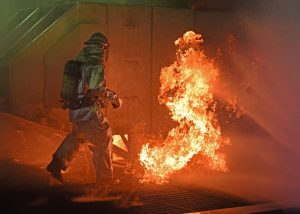
Besides Damage Controlman Class “A” technical school, the Navy expects and encourages Navy Controlman to complete self-paced Non-Resident Training Courses (NRTC) and relative Personnel Qualification Standards (PQS) when they get to the fleet to enhance their knowledge and increase their promotion opportunities.
They should also pursue warfare qualifications depending on their duty station, such as:
- ESWS (Enlisted Surface Warfare Specialist)
- EAWS (Enlisted Aviation Warfare Specialist)
- Submarine Warfare (SSW) – Enlisted
In addition, The Navy provides online training to qualified Navy DC’s through their Credentialing Opportunities On-Line website, referred to as Navy COOL.
Advanced Damage Control- and Firefighting-related training is available to Damage Controlman as their Navy career progresses.
How Much Are Navy Damage Control Specialists Paid?
Like all other enlisted personnel (in all branches), the Navy bases a sailor’s pay on their rank and length of service.
Navy Damage Controlman may be entitled to other forms of compensation including base allowance for housing (BAH), base allowance for subsistence (BAS), and billet pay (sea pay, submarine pay, hazardous duty pay, etc.) if eligible.
Related Article: Navy Ranks And Pay For 2019
What’s Life Like as a Navy Damage Controlman?
Navy DC’s are the ‘first responders’ of the fleet.
The duties of a Damage Controlman are wide and varied. They include:
- The operation, repair, and maintenance of installed firefighting systems and equipment damage control equipment, and chemical, biological and radiological (CBR) defense equipment.
- Train shipboard personnel in the operation, maintenance, and repair of damage control systems equipment, life-saving devices, and various firefighting methods.
- Perform maintenance and repair of watertight closures and assorted fittings.
- Perform emergency repairs to decks, hulls, and structures by pipe patching, plugging, and shoring.
- Perform emergency repairs to pipe fittings and fixtures.
- Serve/act as ships Fire Marshal and firefighting leaders.
- Train ship’s crew in chemical, biological, and radiological defense.
The work environment in which they might find themselves vary widely and often are dependent if the Damage Controlman is on sea duty or shore duty.
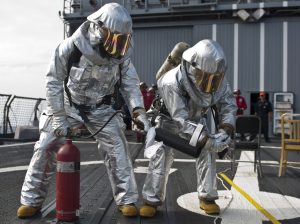
At sea, their work is normally performed in a controlled climate. However, Damage Controlman often work in noisy environments on machinery spaces and flight decks in different weather conditions and sea states.
DC’s work closely with others daily. Their work is physical, often stressful, and can include long hours.
As all sailors fight fires if one should occur onboard ship, they usually supervise and train their shipmates.
Damage Controlman often get confused with Hull Technicians (HT) by civilians and old sailors, alike.
This is because from 1972 to 1988, Hull Technicians assumed all the roles and responsibilities of Damage Controlman.
However, in 1988, the Navy realized that the responsibilities of shipboard damage control were so great that it required a dedicated rate.
The Damage Controlman (DC) rate was activated that some year.
Although OMK lists Damage Controlman as one of the Five Absolute Worse Jobs in the Navy, you will find current and past Damage Controlman who disagree.
One active duty Damage Controlman posted advice to a young person contemplating joining the Navy as a Damage Controlman, on a social website.
“I personally love my job. It wasn’t my first choice, and I kind of fell into this rate. But I haven’t regretted that decision in the least. I will tell you that EVERYONE needs DC training, so hookups on the ship can be a part of your life if you work it right. That really helps in the ‘like your job’ department.”
DC2 Chris Kellog of the USS Vella Gulf (CG 72) describing his average day in Navy Live wrote, “The long hours can be hard, but the Navy has provided me with some incredible opportunities. How many 25-year-olds can say they supported our NATO allies in the Black Sea, or conducted training in the middle of the ocean, or performed emergency repairs to a ship in the middle of the night? For me, it is just another day in the Navy.”
The USS Kitty Hawk’s (CV 63) DC2 Robert Beckwith simply states, “I enjoy what I do and usually don’t get stressed out.”
Shipmate DC3 David Bateman adds, “We joke around to lighten things up and relieve stress.”
The job of a Navy DC is stressful and physical. Having to train the crew in firefighting and damage control requires a lot of patience and the day-to-day duties of training, inspection, and maintenance can be monotonous sometimes. However, that is true of all rates in the Navy.
Typical Rotation
Sailors in specific jobs (or rates as the Navy refers to them) must adhere to a Sea/Shore rotation based on their rate.
The Damage Controlman rate is one of the most sea-intensive rates in the US Navy.
During a twenty-year career in the Navy, Damage Controlman will spend about 65 percent of their career at sea, and 35 percent assigned to shore stations.
Specifically, the Sea/Shore rotation for a DC is:
| Tour | Sea Tour | Shore Tour |
|---|---|---|
| First Tour | 60 Months (5 Years) | 36 Months (3 Years) |
| Second Tour | 60 Months (5 Years) | 36 Months (3 Years) |
| Third Tour | 48 Month (4 Years) | 36 Months (3 Years) |
| Fourth Tour | 48 Month (4 Years) | 36 Months (3 Years) |
| Fifth Tour | 36 Months (3 Years) | 36 Months (3 Years) |
| Sixth Tour | 36 Months (3 Years) | 36 Months (3 Years) |
| Seventh Tour | 36 Months (3 Years) | 36 Months (3 Years) |
Note that some overseas assignments count as sea tours.
Shipboard life and life on shore duty are drastically different. The Navy expects Damage Controlman, as they do all their sailors, to adapt and meet the challenges presented by these different environments.
Here are a few reviews we happened across on indeed.com from ex- and current Navy DC’s:

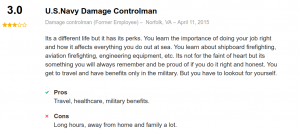



Navy Damage Controlman enjoy the same benefits as do all Navy personnel, such as the opportunity to travel the world, unlimited opportunities for learning and advancement, and control over their career.
Civilian Career Opportunities
Civilian career opportunities for Navy Damage Controlman are plentiful. These include municipal firefighters, emergency management directors, emergency medical technicians, paramedics, fire inspectors, occupational health and safety specialists, plumbers, and pipefitters and steamfitters.
This is especially true if the sailor takes full advantage of on-the-job training (OJT), training opportunities, and educational opportunities offered and afforded them during their naval service.
Related Article – Dishonorable Discharge: Reasons, Consequences, And More
The United States Military Apprenticeship Program (USMAP) also allows Controlman to complete their civilian apprenticeship requirements while on active duty.
According to cool.navy.mil, these apprenticeships include pump repairer and firefighter, among others.
If you are considering the US Navy, are not afraid of danger and hard work, and are seeking adventure, a career as a Navy DC might just be for you.
References
Navy Damage Controlman Reviews
Navy COOL Summary For Damage Controlman (DC)
- Gas Turbine Systems Technician (GSM and GSE): Career Details - June 18, 2024
- Interior Communications Electrician (IC): 2023 Career Details - June 18, 2024
- Religious Program Specialist (RP): 2023 Career Details - June 18, 2024

